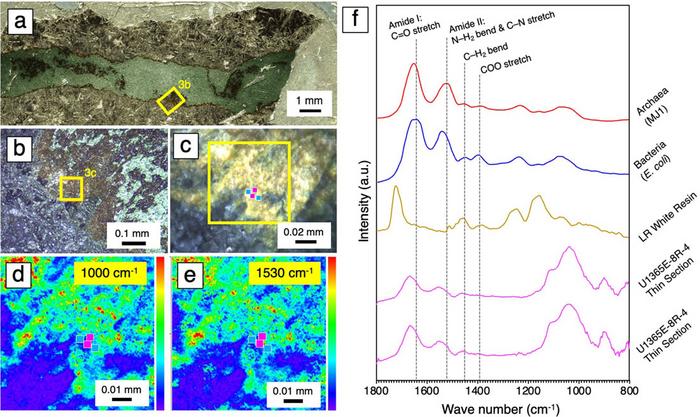In an era defined by rapid advancements in space exploration, the vital quest for understanding whether life exists beyond our planet remains at the forefront of scientific inquiry. With multiple Mars sample return missions on the horizon, researchers are concerned not only with the fascinating prospect of finding extraterrestrial life but also with the potential implications of bringing back samples containing microbial entities. This necessity for heightened scrutiny has catalyzed a new wave of innovative research and technology development aimed at detecting life in Martian analogues here on Earth.
A groundbreaking study led by an international team, including scientists from the University of Tokyo and NASA, has demonstrated a novel method for detecting ancient microbial life in rock samples that mimic the geology of Mars. This research is pivotal as it aims to establish protocols for the safe analysis of Martian samples while addressing the potential risks associated with sample return missions. The complexity of this endeavor cannot be overstated. As humanity prepares to explore the Martian surface more intimately, the stakes are extraordinarily high. Contaminating Earth with extraterrestrial microbes could have unforeseen and potentially catastrophic consequences.
The international Committee on Space Research (COSPAR) has recognized these risks and developed a comprehensive sample safety assessment framework. Established protocols aim to minimize the risk of contamination during the collection, transportation, and examination of Martian rock samples. A significant challenge lies in the fact that, so far, there have been no confirmed biological samples from Mars, thus creating an urgent need for researchers like Associate Professor Yohey Suzuki and his dedicated team to discover effective methods for detecting such life forms. The study, which investigates ancient rocks rich in microbial life analogous to potential Martian samples, marks an essential step in this direction.
Initially, conventional analytic methods used in microbiology proved inadequate, failing to locate microbial cells within ancient rock formations. Informative discussions within the research team highlighted the necessity of employing a technique sensitive enough to discern life that has survived within 100-million-year-old basalt rock. Instead of expending existing resources on techniques that demanded extensive sample preparation, troops in the lab pivoted towards a pioneering technology: optical photothermal infrared (O-PTIR) spectroscopy.
O-PTIR represents a transformative approach to microbial analysis, shining infrared light onto the surfaces of prepared samples to elicit valuable insights. The researchers meticulously designed their methodology, removing outer layers of the rocks to aid in the analysis without compromising the integrity of the remaining material. This preservation-centric philosophy echoes the approach taken during the moon landings when scientists developed protocols to protect lunar samples from contamination and degradation.
The results from the application of O-PTIR spectroscopy were extraordinary, uncovering details within the samples at a resolution of half a micrometer—an unparalleled achievement in the quest to distinguish living structures within ancient rock. The pioneering aspect of this study lies in its non-destructive methodology, allowing for extensive future testing on preserved samples, which is essential given the rarity of anticipated Martian materials. These developments provide an optimistic outlook for the future of Astrobiology, inspiring scientists who seek to unravel the mysteries of microbial life both on Earth and beyond.
Further exploring the implications of their findings, the research team acknowledges the need to extend the capabilities of their instrument to examine older basalt rock approximating two billion years old. Such ancient samples have long been considered analogues for study as they mirror the geological contexts from which Martian samples will soon be retrieved. In examining these archaic rocks, researchers can refine their techniques to foster significant breakthroughs in astrobiological investigations.
Additionally, Associate Professor Suzuki expressed excitement about exploring various rock types, especially carbonates, which frequently harbor microbial life both on Earth and potentially on Mars. This ongoing study represents a remarkable crossroad in the field, offering researchers a chance to apply innovative technologies directly to pressing scientific inquiries. The anticipation of uncovering ancient microbial life invites immense intrigue and serves as a rallying cry for scientists dedicated to pushing the boundaries of our collective knowledge.
As the exploration of Mars intensifies and sample return missions inch closer to reality, the implications of this research extend far beyond the realm of theoretical exploration. Many researchers perceive a pivotal moment lies within reach, where answers about the existence of life beyond Earth could emerge unequivocally. The natural curiosity that propels scientific investigation drives the broader narrative, intertwining humanity’s quest for knowledge with our innate desire to understand our cosmic significance.
In conclusion, as the scientific community looks towards an imminent future of Mars exploration, the footsteps of research, such as that conducted by Suzuki and his team, signal overwhelming promise. The world watches closely, eager for revelations that could alter humanity’s understanding of life itself. By employing cutting-edge techniques like O-PTIR spectroscopy, scientists are on the verge of potentially transformative discoveries that may redefine our relationship with the universe. The way forward rests firmly in their hands, and as they endeavor into unexplored territories, the answers to one of humanity’s greatest questions may soon come pushing through the dust of time.
Subject of Research: Detection of microbial life in Mars-analogue rocks
Article Title: Submicron-scale detection of microbes and smectite from the interior of a Mars-analogue basalt sample by optical photothermal infrared spectroscopy
News Publication Date: 19-Feb-2025
Web References: International Journal of Astrobiology
References: Yohey Suzuki et al. (2025) International Journal of Astrobiology
Image Credits: ©2025 Suzuki et al. CC-BY-ND
Keywords
Mars, microbial life, astrobiology, optical photothermal infrared spectroscopy, geobiology, sample return missions, ancient rocks, COSPAR, Earth contamination, Mars exploration.




